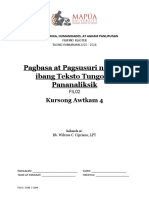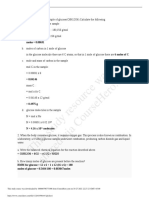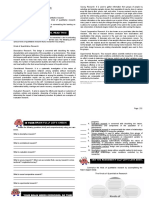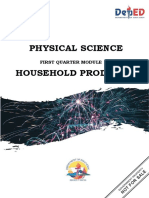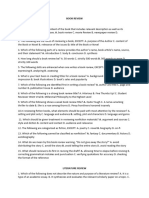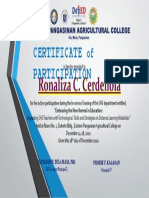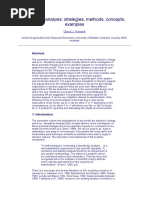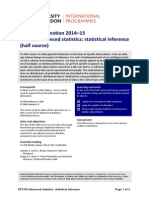SUMMATIVE TEST Week 34
SUMMATIVE TEST Week 34
Uploaded by
Ronaliza CerdenolaCopyright:
Available Formats
SUMMATIVE TEST Week 34
SUMMATIVE TEST Week 34
Uploaded by
Ronaliza CerdenolaOriginal Title
Copyright
Available Formats
Share this document
Did you find this document useful?
Is this content inappropriate?
Copyright:
Available Formats
SUMMATIVE TEST Week 34
SUMMATIVE TEST Week 34
Uploaded by
Ronaliza CerdenolaCopyright:
Available Formats
SUMMATIVE TEST
Practical Research 1
Quarter 4 Week 3 & 4
1. This type of data gathering instrument is used when the researcher personally asks the
respondents about the information that the researcher needs.
A. Observation C. FGD
B. Interview D. Questionnaire
2. It is a form of interview wherein the researcher uses an interview schedule and uses a set of
prepared questions, which are unchangeable, to ask from one respondent to another.
A. Unstructured interview C. Structured Interview
B. Semi-structured interview D. Group Interview
3. This type of data collection method is used when the study participants are very young children
and those with disabilities.
A. Observation C. FGD
B. Interview D. Document Review
4. Maya used an unstructured interview as her data gathering instrument for her research. What
type of data will Maya get from her respondents? 7
A. Answers that are straight to the point based on what is written on her interview
questions.
B. Answers that are conversation-like because her questions are based on her outline only.
C. Answers that are based on her interview questions and follow up answers that are not
found on her written questions
D. None of the Above
5. What type of data gathering instrument is best used for Ethnographic studies?
A. Observation C. FGD
B. Interview D. Questionnaire
6. Which does not belong to the pair of qualitative inquiry and data gathering instrument? A.
Ethnography: Observation
B. Grounded theory: Interview
C. Historical Approach: Questionnaire
D. Phenomenology: Interview
7. Sophia wants to study the behavior of baby pandas when placed in a controlled
environment. What data gathering instrument will Sophia be using?
A. Observation C. FGD
B. Interview D. Questionnaire
8. As a researcher, how are you going to use phenomenology as an approach to a
qualitative study about the victims of typhoon Yolanda? A. Ask the victims on their experiences
during the typhoon B. Look for historical data about instances where the victims were also victims
of flooding in the past
C. Have an in-depth understanding on the socio-economic impact of typhoons
D. Formulate a theory
9. What is the difference between naturalistic observation and non-naturalistic observation?
A. The difference is on how the researcher approach their respondent
B. The difference is on the type of environment that the subjects are to be observed
C. The difference is on the experience of the researcher based on the type of observation
D. There is no difference
10. The following are considered as data gathering instrument except:
A. Interviews C. Questionnaire
B. Observation D. Internet
You might also like
- Region 1 Schools Division Office II of Pangasinan Eastern Pangasinan Agricultural CollegeDocument44 pagesRegion 1 Schools Division Office II of Pangasinan Eastern Pangasinan Agricultural CollegeRonaliza Cerdenola89% (19)
- Celonis Introduction PresentationDocument38 pagesCelonis Introduction PresentationAjinkya Chavan100% (2)
- LAS Module 1 PR2 Ver 2 SecuredDocument6 pagesLAS Module 1 PR2 Ver 2 SecuredKhaira PeraltaNo ratings yet
- Practical Research 1Document48 pagesPractical Research 1Shiahari Cortez50% (2)
- Practical Research 1 LAS Weeks 3 and 4Document16 pagesPractical Research 1 LAS Weeks 3 and 4Aruel Delim100% (1)
- SENIOR HIGH SCHOOL-Practical Research 1: I. Learning SkillsDocument8 pagesSENIOR HIGH SCHOOL-Practical Research 1: I. Learning SkillsSimon Ardel Rosin100% (2)
- PR2 Q2 Module 4Document11 pagesPR2 Q2 Module 4Magsanay beaaneeza100% (1)
- Practical Research: Nicole A. Rosario 11 - AnimationDocument7 pagesPractical Research: Nicole A. Rosario 11 - AnimationAnalyn RosarioNo ratings yet
- Patterns of Development in Writing Across Disciplines: Reading and Writing SkillsDocument4 pagesPatterns of Development in Writing Across Disciplines: Reading and Writing SkillsMark Give De LeonNo ratings yet
- Concept Explanation: Activity 1 Directions: Answer Each Question IntelligentlyDocument2 pagesConcept Explanation: Activity 1 Directions: Answer Each Question IntelligentlyArianne Valenzuela0% (1)
- Practical Research 121Document2 pagesPractical Research 121Ericka Rivera Santos100% (1)
- Reading and Writing Q2 Week 2Document6 pagesReading and Writing Q2 Week 2Rhynz BanastonNo ratings yet
- Synthesized Example: Nabua Nationalhigh School San Miguel, Nabua, Camarines Sur School - ID 302001Document4 pagesSynthesized Example: Nabua Nationalhigh School San Miguel, Nabua, Camarines Sur School - ID 302001Oliver100% (1)
- EAPP Lesson 1 Week 6Document17 pagesEAPP Lesson 1 Week 6Jemerlyn De Los ReyesNo ratings yet
- PR 2 NotesDocument3 pagesPR 2 NotesShane FriasNo ratings yet
- Stat and Prob - Q4 Week 4 - Module 12 Hilario GarciaDocument18 pagesStat and Prob - Q4 Week 4 - Module 12 Hilario Garciagabezarate071100% (1)
- Practical Research 2 FinalDocument13 pagesPractical Research 2 Finalreymark batbatanNo ratings yet
- Exam Mam ChanDocument3 pagesExam Mam ChanEustass KiddNo ratings yet
- Q4 LAS 1.testing Hypothesis Q4M1Document20 pagesQ4 LAS 1.testing Hypothesis Q4M1Jaehyuk JeongwooNo ratings yet
- Pagbasa at Pagsusuri NG Iba't Ibang Teksto Tungo Sa PananaliksikDocument5 pagesPagbasa at Pagsusuri NG Iba't Ibang Teksto Tungo Sa PananaliksikKid KulafuNo ratings yet
- Reading and Writing ModuleDocument2 pagesReading and Writing ModuleJimboy Maglon100% (2)
- Template - 4SHS-Module-Practical Research 1Document17 pagesTemplate - 4SHS-Module-Practical Research 1Jeanny Mae Pesebre50% (2)
- Representative Texts and Authors From The World: Quarter 2 - Module 7Document10 pagesRepresentative Texts and Authors From The World: Quarter 2 - Module 7GODWIN Gaming100% (2)
- Practical Research 2 12 q1 Mod1 Week 1 Day 1 To 5Document29 pagesPractical Research 2 12 q1 Mod1 Week 1 Day 1 To 5Ester RodulfaNo ratings yet
- Prac Res Q2 Module 8Document12 pagesPrac Res Q2 Module 8Benicel Lane De VeraNo ratings yet
- This Study Resource Was: Moles 0.00691Document2 pagesThis Study Resource Was: Moles 0.00691Remar Jhon PaineNo ratings yet
- Practical Research 2: Quarter 1 - Module 2: Importance of Quantitative Research Across FieldsDocument16 pagesPractical Research 2: Quarter 1 - Module 2: Importance of Quantitative Research Across FieldsDivina Grace Rodriguez - LibreaNo ratings yet
- Week 3 Reading and Writing PDFDocument6 pagesWeek 3 Reading and Writing PDFReyes EricaNo ratings yet
- Activity 1.6Document3 pagesActivity 1.6Sonoko SuzukiNo ratings yet
- Practical Research 2Document12 pagesPractical Research 2Joshua Paul Fernandez100% (1)
- Group 5 Ucsp Module 5 Group ActivitiesDocument7 pagesGroup 5 Ucsp Module 5 Group ActivitiesAkisha FijoNo ratings yet
- Stat Prob Week 5 6Document15 pagesStat Prob Week 5 6jayson santos0% (1)
- PRACTICAL RESEARCH Module 2 Lesson 1-3Document14 pagesPRACTICAL RESEARCH Module 2 Lesson 1-3Karla Carbonel100% (1)
- Practical Research 1 Module 7Document4 pagesPractical Research 1 Module 7Daphnie RiveraNo ratings yet
- pr2 Module 1 Q2Document16 pagespr2 Module 1 Q2dv vargasNo ratings yet
- PR2 Q2 Module 3Document9 pagesPR2 Q2 Module 3Ashes VillNo ratings yet
- Understanding Culture, Society and Politics: Accessible Teachers MaterialsDocument5 pagesUnderstanding Culture, Society and Politics: Accessible Teachers MaterialsMary Ann PaladNo ratings yet
- What I Know: Introduction To Philosophy of The Human Person Module 4 - Human Person and DeathDocument4 pagesWhat I Know: Introduction To Philosophy of The Human Person Module 4 - Human Person and DeathKimchiiNo ratings yet
- Lesson 18Document15 pagesLesson 18Ivy Mae SagangNo ratings yet
- 21stCL Q1 M10Document14 pages21stCL Q1 M10Anna Marie AgravanteNo ratings yet
- Q4-Summative Test 2 - Practical Research 1Document2 pagesQ4-Summative Test 2 - Practical Research 1julieanne_portal67% (9)
- G12 SLM4 PR2 Q4 v2 - FinalDocument26 pagesG12 SLM4 PR2 Q4 v2 - FinalNancy LantinganNo ratings yet
- Practical Research I: Quarter 1 - Module 2Document16 pagesPractical Research I: Quarter 1 - Module 2Marvin M Pulao75% (8)
- Core-Physical Science Q1 SLM - 10Document18 pagesCore-Physical Science Q1 SLM - 10Michael Marjolino EsmendaNo ratings yet
- Senior High School Department: Practical Research IiDocument6 pagesSenior High School Department: Practical Research IiEben Alameda-PalapuzNo ratings yet
- Structural FunctionalismDocument21 pagesStructural FunctionalismJessebel Dano AnthonyNo ratings yet
- Worksheet 1Document14 pagesWorksheet 1TcherKamilaNo ratings yet
- Lifetime Commitment of SelflessnessDocument2 pagesLifetime Commitment of SelflessnessGil BertNo ratings yet
- Lesson 2 Chapter 5-2Document38 pagesLesson 2 Chapter 5-2RHEA GENIONo ratings yet
- WK5 Q1 Oct.1121 Writing The Reaction PaperDocument21 pagesWK5 Q1 Oct.1121 Writing The Reaction PaperHanna Shane EsplanaNo ratings yet
- 21st - Module3Document12 pages21st - Module3Antonette SofieNo ratings yet
- PR2 LESSON 3 Kinds of Quantitative ResearchDocument3 pagesPR2 LESSON 3 Kinds of Quantitative ResearchMiles MendozaNo ratings yet
- Career Decision Making-1Document1 pageCareer Decision Making-1SofiaNo ratings yet
- Reading & Writing ReviewerDocument8 pagesReading & Writing ReviewerShaine CariagaNo ratings yet
- 21st Century Literature From The Philippines and The World - Quarter1 - Module1 - Lesson1Document10 pages21st Century Literature From The Philippines and The World - Quarter1 - Module1 - Lesson1Lagumen Mark AnthonyNo ratings yet
- IV. Pre-Test: FashionDocument4 pagesIV. Pre-Test: FashionJames Andrei CantreNo ratings yet
- Module Reading Writing Quarter 4Document94 pagesModule Reading Writing Quarter 4Apple James Orpiza IbitNo ratings yet
- READING AND WRITING - Q1 - W2 - Mod2Document13 pagesREADING AND WRITING - Q1 - W2 - Mod2Gabriel CabansagNo ratings yet
- Practical Research 2 - Importance of Quantitative Research Across Fields MELC 2 - LAS 1Document12 pagesPractical Research 2 - Importance of Quantitative Research Across Fields MELC 2 - LAS 1Marjorie Villanueva Perez100% (2)
- QTR 4 - Module 5Document11 pagesQTR 4 - Module 5Ginevieve GibertasNo ratings yet
- G11 FQ PractIcal Research 1 Module 5Document27 pagesG11 FQ PractIcal Research 1 Module 5Ericka Mae TayamoraNo ratings yet
- 4 Data GatheringDocument44 pages4 Data GatheringjohnfreddmonteroNo ratings yet
- Adjusted Awa of SHS TeachersDocument36 pagesAdjusted Awa of SHS TeachersRonaliza CerdenolaNo ratings yet
- Eastern Pangasinan Agricultural College: Inquiries, Investigations and Immersion Summative Test Quarter 3 Week 1Document2 pagesEastern Pangasinan Agricultural College: Inquiries, Investigations and Immersion Summative Test Quarter 3 Week 1Ronaliza CerdenolaNo ratings yet
- Brigada Eskwela LETTER OF INVITATIONDocument1 pageBrigada Eskwela LETTER OF INVITATIONRonaliza Cerdenola100% (1)
- Weekly Home Learning Plan Quarter 1, Week 5:) Grade & Section: 11-CIRCINUS (STEM) Date/s Covered: November 23-27, 2020Document4 pagesWeekly Home Learning Plan Quarter 1, Week 5:) Grade & Section: 11-CIRCINUS (STEM) Date/s Covered: November 23-27, 2020Ronaliza CerdenolaNo ratings yet
- Title: Impact of Modular Learning Amidst Covid-19 Pandemic To Senior High School StudentsDocument16 pagesTitle: Impact of Modular Learning Amidst Covid-19 Pandemic To Senior High School StudentsRonaliza CerdenolaNo ratings yet
- Learning Delivery Modalities: Teacher'sDocument7 pagesLearning Delivery Modalities: Teacher'sRonaliza CerdenolaNo ratings yet
- Class Record: 1St Semester Second QuarterDocument30 pagesClass Record: 1St Semester Second QuarterRonaliza CerdenolaNo ratings yet
- Checklist of A.S. SubmittedDocument29 pagesChecklist of A.S. SubmittedRonaliza CerdenolaNo ratings yet
- Certificate Participation: Ronaliza C. CerdeñolaDocument1 pageCertificate Participation: Ronaliza C. CerdeñolaRonaliza CerdenolaNo ratings yet
- Checklist of A.S. Submitted: 11-CircinusDocument1 pageChecklist of A.S. Submitted: 11-CircinusRonaliza CerdenolaNo ratings yet
- Letter - Training CompletionDocument1 pageLetter - Training CompletionRonaliza CerdenolaNo ratings yet
- ParallaxDocument1 pageParallaxRonaliza CerdenolaNo ratings yet
- Senior High School Department: Brief Summary of The Training ConductedDocument1 pageSenior High School Department: Brief Summary of The Training ConductedRonaliza CerdenolaNo ratings yet
- Senior High School Department: Summary of First Quarter GradesDocument4 pagesSenior High School Department: Summary of First Quarter GradesRonaliza CerdenolaNo ratings yet
- Eastern Pangasinan Agricultural: CollegeDocument2 pagesEastern Pangasinan Agricultural: CollegeRonaliza CerdenolaNo ratings yet
- Module 5 4th QuarterDocument1 pageModule 5 4th Quarterfoh1116No ratings yet
- Tugas Uji Asumsi KlasikDocument6 pagesTugas Uji Asumsi KlasikCandra GunawanNo ratings yet
- Performance Metrics For R&DDocument44 pagesPerformance Metrics For R&Dadalcayde2514No ratings yet
- Anchoring of Inflation Expectations and Monetary Policy Transparency in IndiaDocument9 pagesAnchoring of Inflation Expectations and Monetary Policy Transparency in IndiaInternational Journal of Application or Innovation in Engineering & ManagementNo ratings yet
- 00000000TheEffectsOfOnlineGameAddictionLevelToAcademicPerformance AutoRecovered AutoRecoveredDocument18 pages00000000TheEffectsOfOnlineGameAddictionLevelToAcademicPerformance AutoRecovered AutoRecoveredblackpink roseNo ratings yet
- HyperHeuristics Theory and ApplicationsDocument134 pagesHyperHeuristics Theory and ApplicationsMahmoud SaidNo ratings yet
- Student's Progress Chart: Regional Science High SchoolDocument17 pagesStudent's Progress Chart: Regional Science High SchoolRizqan HairulNo ratings yet
- Qualitative Research Traditions - A Review - Jacob 1987Document50 pagesQualitative Research Traditions - A Review - Jacob 1987ayesha.mariamNo ratings yet
- Sensitivity Analysis: Strategies, Methods, Concepts, ExamplesDocument21 pagesSensitivity Analysis: Strategies, Methods, Concepts, ExamplesSumanta Basu RoyNo ratings yet
- Basic Concepts of StatisticsDocument13 pagesBasic Concepts of StatisticsChristine Leal-EstenderNo ratings yet
- Reporting Systematic Review. Moher Et Al. BMJ 2009Document5 pagesReporting Systematic Review. Moher Et Al. BMJ 2009Jonathan PratamaNo ratings yet
- Dmaic QuizDocument6 pagesDmaic QuizARABELLA MALLARINo ratings yet
- Hubungan Pendidikan Dan Kinerja Dengan Kepuasan Kerja Perawat Di Ruang Rawat Inap Rsud Kabupaten PamekasanDocument6 pagesHubungan Pendidikan Dan Kinerja Dengan Kepuasan Kerja Perawat Di Ruang Rawat Inap Rsud Kabupaten Pamekasananita sahrirNo ratings yet
- Forecasting: Chapter Three Operations Management William J. StevensonDocument13 pagesForecasting: Chapter Three Operations Management William J. StevensonJahirul Islam ShovonNo ratings yet
- Precise Determination of Low Level Sulfur in Oil According To ASTM D2622-98Document2 pagesPrecise Determination of Low Level Sulfur in Oil According To ASTM D2622-98faheemqcNo ratings yet
- Chapter 1 Introduction To Biology and Laboratory RulesDocument15 pagesChapter 1 Introduction To Biology and Laboratory RulesJaslyn YongNo ratings yet
- 134 CisDocument2 pages134 CisS.L.L.CNo ratings yet
- 8D ApproachDocument44 pages8D Approachdhir.ankurNo ratings yet
- UPSI Thesis GuidelineDocument48 pagesUPSI Thesis GuidelinevictorchanNo ratings yet
- Chi-Square Test: by Dr. M.Supriya Moderator:Dr.B.Aruna, M.D. (H)Document75 pagesChi-Square Test: by Dr. M.Supriya Moderator:Dr.B.Aruna, M.D. (H)Nic OleNo ratings yet
- Our Lady of Fatima University: Olfu VisionDocument8 pagesOur Lady of Fatima University: Olfu VisionJerwin SamsonNo ratings yet
- It'S All About Ethnography and Ethnographic ResearchDocument16 pagesIt'S All About Ethnography and Ethnographic Researchtemesgen abebeNo ratings yet
- 1984 - Critical ThinkingDocument10 pages1984 - Critical ThinkingDespina KalaitzidouNo ratings yet
- Physics Teacher Guide@FreshexamsDocument63 pagesPhysics Teacher Guide@FreshexamsMotuma FekaduNo ratings yet
- First Parallel Test in Practical Research 1: Godwino Integrated SchoolDocument4 pagesFirst Parallel Test in Practical Research 1: Godwino Integrated SchoolChariza L. Pacurib100% (2)
- Estimation and Confidence Intervals: Properties of Point EstimatesDocument14 pagesEstimation and Confidence Intervals: Properties of Point EstimatesdipanajnNo ratings yet
- (Analysis of Variance) : AnovaDocument22 pages(Analysis of Variance) : AnovaJoanne Bernadette IcaroNo ratings yet
- SUMMARY of Daniel J. McNamara's Article "A Return To The Beginnings"Document3 pagesSUMMARY of Daniel J. McNamara's Article "A Return To The Beginnings"Orlando Umali100% (3)
- COREQ 32 Item ChecklistDocument9 pagesCOREQ 32 Item Checklistcharmainetanxy99No ratings yet



















